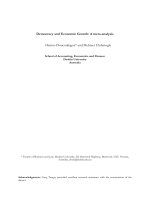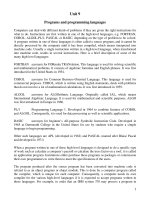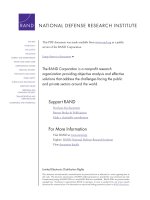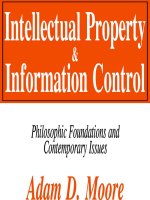Beyond (Straight and Gay) Marriage pdf
Bạn đang xem bản rút gọn của tài liệu. Xem và tải ngay bản đầy đủ của tài liệu tại đây (2.72 MB, 270 trang )
Beyond (Straight and Gay) Marriage
Beyond
(Straight and Gay)
Marriage
Va luing All Families
under the Law
Nancy D. Polikoff
Beacon Press
Boston
Beacon Press
25 Beacon Street
Boston, Massachusetts 02108-2892
www.beacon.org
Beacon Press books
are published under the auspices of
the Unitarian Universalist Association of Congregations.
© 2008 by Nancy D. Polikoƒ
All rights reserved
Printed in the United States of America
11 10 09 08 8 7 654321
This book is printed on acid-free paper that meets
the uncoated paper ANSI/NISO specifications
for permanence as revised in 1992.
Te xt design and composition by Tag Savage
at Wilsted & Taylor Publishing Services
Polikoff, Nancy D.
Beyond (straight and gay) marriage : valuing all families under the law /
Nancy D. Polikoff.
p. cm.
Includes bibliographical references and index.
isbn 978-0-8070-4432-2
1. Unmarried couples—Legal status, laws, etc.—United States.
2. Domestic partner benefits—Law and legislation—United States.
3. Same-sex marriage—Law and legislation—United States. 4. Civil
unions—Law and legislation—United States. 5. Gay couples—
Legal status, laws, etc.—United States. 6. Lesbian couples—Legal
status, laws, etc.—United States. I. Title.
kf538.p65 2007
346.7301'6—dc22 2007021330
To my teachers, especially
Horace Ports (in memoriam)
Judith Fetterley
Judith Areen
A Note from the Series Editor ix
Introduction 1
ONE The Changing Meaning of Marriage 11
TWO Gay Rights and the Conservative Backlash 34
THREE Redefining Family 46
FOUR The Right and the Marriage Movement 63
FIVE LGBT Families and the
Marriage-Equality Movement 83
SIX Countries Where Marriage Matters Less 110
SEVEN Va luing All Families 123
EIGHT Domestic Partner Benefits for All Families 146
NINE Coping with Illness: Medical Care
and Family and Medical Leave 159
TEN When a Relationship Ends through
Dissolution or Death: Distributing
Assets and Providing for Children 174
ELEVEN Losing an Economic Provider:
Wrongful Death, Workers’
Compensation, and Social Security 193
Conclusion 208
Acknowledgments 215
Notes 217
Index 243
The history of the LGBT movement has been a serpentine series of
crusades to identify and combat the myriad legal discriminations,
oppressions, and social proscriptions that faced its constituents.
Choosing what battles to fight—for any group—is always a compli-
cated historical and cultural process, and the choices made depend
on a wide range of factors. In recent years the battle for marriage
equality has become, for many activists, the central struggle of the
fight for lesbian and gay rights. This is understandable since marriage
equality deals with relationships, legal rights, medical and economic
benefits, and sustaining family units. But in the midst of any conflict
it is often di‰cult to see the broader picture—and other options.
Nancy Polikoƒ’s Beyond (Straight and Gay) Marriage: Valuing All
Families under the Law is one of the first books to examine, in detail
and with a plethora of real-life as well as legal examples, what all fam-
ilies need to survive in a world that is becoming, socially and eco-
nomically, increasingly harsh and complicated. Polikoƒ’s brilliant
and incisive legal analysis cuts through the arguments for and against
same-sex marriage recognition to show us that both sides are argu-
ing from a place that misses the larger picture of what all families—
of whatever configuration—need to continue to support themselves
and flourish. Drawing on cutting-edge family law, feminist theory,
and plain old common sense, Polikoƒ brings us a vision of how we,
as a society, can legally and ethically value everyone’s desire for fam-
ily, stability, and security. In many ways Beyond (Straight and Gay)
Marriage oƒers us a vision of the LGBT movement as it grows up to
become as mature, inclusive, and progressive as its potential has al-
ways indicated it could be.
Series Editor
Karen Thompson had a problem. Her lover of four years, Sharon Ko-
walski, lay in a hospital bed, having suƒered a brain injury caused
when a car operated by a drunk driver collided with her car on a
stormy Minnesota night. Because Karen wasn’t a family member, the
nursing staƒ would not let her see Sharon; this would be the begin-
ning of a decade-long struggle pitting Karen against Sharon’s parents
over control of Sharon’s treatment.¹
Susan Burns had a problem. The divorce decree awarding custody
of her three children to their father stated that the children could not
visit her if at any time during their stay she was living with or spend-
ing overnights with a person to whom she was not legally married.
More than four years later, on July 1, 2000, Vermont instituted civil
unions for same-sex couples. Susan entered into a civil union with
her partner on July 3. When the children spent the night in the home
Susan shared with her partner, a judge found her in contempt of
court.²
Larry Courtney had a problem. His partner of fourteen years, Eu-
gene Clark, did not come home from his job on the 102nd floor of the
south tower of the World Trade Center on September 11, 2001. When
Larry filed a workers’ compensation claim, the reviewing agency
replied that he did not qualify for benefits, which might instead be
paid to Eugene’s father, from whom Eugene had been estranged for
twenty years.³
Lisa Stewart had a problem. At thirty-three, and with a five-year-
old daughter, Emily, she was diagnosed with breast cancer, which be-
came terminal. She was unable to continue working as a real estate
appraiser and lost her income and her health insurance. Her partner
of ten years, Lynn, had insurance through her job, but it did not cover
Lisa and Emily. Lisa and Lynn live in South Carolina, which does not
allow “second-parent” adoption, so Lisa is Emily’s only legally rec-
1
ognized parent. When Lisa dies, Emily will receive Social Security
survivors’ benefits, but Lynn will not.⁴
A consumer of current news might imagine that access to same-
sex marriage is the most contested issue in contemporary family pol-
icy, and that marriage is the only cure for the disadvantages faced by
lesbian and gay families. Both of these observations would be wrong.
The most contested issue in contemporary family policy is whether
married-couple families should have “special rights” not available to
other family forms. Excluded families include unmarried couples of
any sexual orientation, single-parent households, extended-family
units, and any other constellation of individuals who form rela-
tionships of emotional and economic interdependence that do not
conform to the one-size-fits-all marriage model. No other Western
country, including those that allow same-sex couples to marry, cre-
ates the rigid dividing line between the law for the married and the
law for the unmarried that exists in the United States.
Consider the situations of the people above. Some may see them
as evidence that same-sex couples must be allowed to marry. If Karen
and Sharon had been married, no one would have questioned Karen’s
right to be Sharon’s guardian. If Susan and her partner were married,
she would not have been in violation of the court order when her
children visited. If Larry and Eugene had been married, Larry would
have received Eugene’s workers’ compensation benefit. If Lisa and
Lynn could marry, Lisa would be covered on Lynn’s health insurance,
Lynn could adopt Emily, and Lisa and Emily would both receive So-
cial Security survivors’ benefits when Lisa died.
I see these stories diƒerently. Karen was the right choice to be
Sharon’s guardian because she knew Sharon best and was indis-
putably committed to her, because Sharon progressed when Karen
worked with her while she was institutionalized, and because Karen
was willing to take Sharon out of an institution and care for her in
their home. Susan and her children were entitled to regular visita-
tion to sustain and support their mother-child relationship, and un-
less her partner was harming the children, the fact that Susan lived
with a partner should not have concerned a family court judge. Larry
and Eugene were an economic unit; Eugene’s death hurt Larry, not
Eugene’s father. Lisa needed healthcare; her daughter needed legal
Beyond (Straight and Gay) Marriage
2
recognition of the two parents she had; and on Lisa’s death, Lynn
needs survivors’ benefits to help her continue raising Emily.
I propose family law reform that would recognize all families’
worth. Marriage as a family form is not more important or valuable
than other forms of family, so the law should not give it more value.
Couples should have the choice to marry based on the spiritual, cul-
tural, or religious meaning of marriage in their lives; they should
never have to marry to reap specific and unique legal benefits. I sup-
port the right to marry for same-sex couples as a matter of civil rights
law. But I oppose discrimination against couples who do not marry,
and I advocate solutions to the needs all families have for economic
well-being, legal recognition, emotional peace of mind, and com-
munity respect.
Consider the following:
Bonnie Cord graduated from law school and began working at a
government agency. She bought a home with her male partner in the
foothills of the Blue Ridge Mountains in Virginia. When she applied
to take the Virginia bar exam—a test necessary to obtain the right to
practice law in the state—a judge ruled that her unmarried cohabi-
tation made her morally unfit to do so.⁵
Catrina Graves was driving her car behind a motorcycle driven
by Brett Ennis, the man with whom she had been living for seven
years. A car failed to stop at a stop sign and hit Brett’s motorcy-
cle; Brett was thrown onto the pavement. Catrina saw the accident,
stopped her car, and ran to Brett, who had suƒered trauma to his
head and was bleeding from the mouth. He died the next day. When
Catrina sued the driver for negligent infliction of emotional distress,
the court dismissed her lawsuit because she was not related to Brett
by blood or marriage.⁶
Olivia Shelltrack and Fondray Loving had lived together for thir-
teen years when they bought a five-bedroom home in Black Jack,
Missouri. They moved in with their two children and a third child
from Olivia’s previous relationship. The city denied them an occu-
pancy permit because its zoning laws prohibit three persons unre-
lated by blood or marriage from living together.⁷
These are heterosexual couples and they could marry. But they
shouldn’t have to. Bonnie’s choice to live with an unmarried part-
Introduction
3
ner bore no relationship to her ability to practice law. Catrina’s an-
guish would have been no diƒerent had Brett been her spouse. The
proper zoning concerns of Black Jack, Missouri, do not turn on
whether Olivia and Fondray marry.
Extending legal rights and obligations to unmarried couples, as
many Western countries do, is a start, but it is not enough. “Couples,”
meaning two people with a commitment grounded on a sexual a‰li-
ation, should not be the only unit that counts as family.
Consider these examples:
As a foster child, Jason was placed with married parents, Daniel
and Mary Lou, who divorced two years later. Jason then lived with
Mary Lou and visited Daniel, who also paid child support. When
Mary Lou and Daniel petitioned to adopt Jason, the court ruled that
unmarried adults could not adopt a child together.⁸
Two sisters in England, Joyce, eighty-eight, and Sybil, eighty, have
lived together all their lives. They grew up on a thirty-acre farm and
worked on the land. They moved away for about fifteen years but re-
turned in 1965, built a home on the land, and leased the farm. They
live oƒ the rental income. They each have wills naming the other as
their beneficiary. When the first sister dies, the 40 percent inheri-
tance tax will make it necessary for the survivor to sell the land and
move. The survivor of a heterosexual married couple or a registered
same-sex civil partnership would not have to pay this tax.⁹
Fifty-nine-year-old Maria Sierotowicz had been living in the
same one-bedroom, subsidized housing unit in Brooklyn since 1984.
Her mother, who lived with her, passed away in 1990. Ten years later,
her eighty-one-year-old father returned to the United States from
Poland and moved in with her so that she could care for him. Maria
followed procedures and requested that he receive permission to join
her Section 8 household. Her request was denied because he wasn’t
her spouse and his presence would make her unit “overcrowded.”
Maria received a notice terminating her Section 8 subsidy.¹⁰
Marriage cannot be the solution to these problems. Jason’s par-
ents tried marriage; it didn’t work for them. They need to be able to
adopt Jason as two unmarried parents, if a judge finds that such an
adoption is in Jason’s best interests. Sybil and Joyce are a family, but
not a family based on marriage or even on a marriage-like relation-
ship. They are a long-term, interdependent unit, and they need—
Beyond (Straight and Gay) Marriage
4
perhaps more than many spouses do—the financial advantages now
extended only to spouses. If Maria had married, her husband would
have automatically received permission to live with her. Instead she
wants to care for someone unable to care for himself. She needs oc-
cupancy rules that do not stand in her way.
It is possible to envision family law and policy without marriage
being the rigid dividing line between who is in and who is out. Keep-
ing the state out of marriage entirely, making marriage only a reli-
gious, cultural, and spiritual matter, would be one way to accomplish
this. But the law would still have to determine how to allocate rights
and responsibilities in families and when relationships among peo-
ple would create entitlements or obligations. This necessity, coupled
with the disruption of expectations that ending the state’s involve-
ment in marriage would produce, suggests another approach.
I call this approach valuing all families. The most important el-
ement in implementing this approach is identifying the purpose of
a law that now grants marriage unique legal consequences. By un-
derstanding a law’s purpose, we can identify the relationships that
would further that purpose without creating a special status for mar-
ried couples.
Sweeping legal changes in the late 1960s and early 1970s altered
the significance of marriage and laid the groundwork for this plural-
istic vision. Those changes grew out of cultural and political shifts,
including feminism and other social-change movements, greater ac-
cess to birth control and acceptance of sex outside marriage, and
increased dissatisfaction with marriage. The legal changes included
decreased penalties on nonmarital sex, especially an end to discrim-
ination against children born to unmarried mothers; equality be-
tween women and men; and no-fault divorce.
Early gay and lesbian rights advocates forged alliances with oth-
ers who challenged the primacy of marriage: divorced and never-
married mothers, including those receiving welfare benefits;
unmarried heterosexuals, both those consciously rejecting the bag-
gage associated with marriage and those who simply did not marry;
and nonnuclear units, such as communal living groups and extended
families. The gay rights movement was part of broader social move-
ments challenging the political, economic, and social status quo and
seeking to transform society into one in which sex, race, class, sexual
Introduction
5
orientation, and marital status no longer determined one’s place in
the nation’s hierarchy. Marriage was in the process of losing its iron-
clad grip on the organization of family life, and lesbians and gay men
benefited overwhelmingly from the prospect of a more pluralistic vi-
sion of relationships.
There were setbacks. A backlash resulted in restrictions on
women’s reproductive freedom, repeal of gay rights laws, and less
support for welfare mothers. Conservatives employed the rhetoric
of “traditional family values” to fight any proposal advancing rec-
ognition and acceptance of lesbian, gay, bisexual, and transgender
(LGBT) people, and used antigay propaganda to raise money and
garner votes for a wide-ranging conservative agenda.
I seek to reclaim and build on the principle that law should sup-
port the diverse families and relationships in which children and
adults flourish.
Since the mid-1990s, two movements have placed marriage in
the public policy spotlight. The “marriage movement”—with both
religious and secular components—opposes not only recognition of
LGBT families but also easily obtained divorce, childbearing and sex
outside marriage, and sex education that teaches anything other than
abstinence. It advocates government funding of “marriage promo-
tion” eƒorts. Its most prominent religion-based groups are Focus on
the Family and the Family Research Council. They speak of a “God-
ordained family.”
David Blankenhorn of the Institute for American Values and
Maggie Gallagher of the Institute for Marriage and Public Policy are
leading spokespeople for the secular claim that supporting any fam-
ily form other than heterosexual marriage endangers the social fab-
ric. By blaming poverty, crime, drug abuse, and education failure on
family diversity, they point the finger at unmarried mothers and ab-
solve government of the responsibility for wage stagnation, income
inequality, poor schools, sex and race discrimination, and inade-
quate childcare and healthcare. Legal groups such as the Alliance
Defense Fund and Liberty Counsel represent these positions in liti-
gation. The mission of Liberty Counsel is “restoring the culture one
case at a time by advancing religious freedom, the sanctity of human
life, and the traditional family.”
The “marriage equality” movement advocates for gay and lesbian
Beyond (Straight and Gay) Marriage
6
couples to be able to marry. Attorney Evan Wolfson heads a national
organization, Freedom to Marry, which has the support of numerous
partner organizations, gay and nongay, at the national, state, and lo-
cal levels. Two national groups, the Human Rights Campaign and the
National Gay and Lesbian Task Force, work to advance many LGBT
rights issues and devote some of their resources to marriage-related
organizing and advocacy. Four legal groups that challenge discrim-
ination against LGBT people in all areas, including employment,
schools, immigration, the military, and family law, have had primary
responsibility for the litigation contesting restrictions on access
to marriage: Lambda Legal (formerly known as Lambda Legal De-
fense and Education Fund); Gay & Lesbian Advocates & Defenders,
the Boston-based group that won the right to marriage equality
in Massachusetts; the American Civil Liberties Union Lesbian Gay
Bisexual Transgender Project; and the National Center for Lesbian
Rights.
Both these movements focus on marriage. Neither starts by iden-
tifying what all families need and then seeking just laws and policies
to meet those needs. The marriage movement does not want to meet
the needs of all families. Its leading spokespeople argue that the in-
trinsic purpose of marriage is uniting a man and a woman to raise
their biological children. They oppose marriage for same-sex cou-
ples, and want marriage to have a special legal status.
The marriage-equality movement wants the benefits of marriage
granted to a larger group: same-sex partners. With few exceptions,
advocates for gay and lesbian access to marriage do not say that
“special rights” should be reserved for those who marry. But the
marriage-equality movement is a movement for gay civil rights, not
for valuing all families. As a civil rights movement, it seeks access to
marriage as it now exists.
The movement’s most consistent claim is that exclusion from
marriage harms same-sex couples in tangible ways. But people in any
relationship other than marriage suƒer, sometimes to a level of eco-
nomic or emotional devastation. The law is not uniquely unfair for
gay and lesbian couples. Access to marriage will provide some gay
men and lesbians with the economic support and peace of mind that
come from knowing that all your family members have adequate
health insurance, that a loved one can make medical decisions for
Introduction
7
you if you are ill, that your economic interdependence will be recog-
nized at retirement or death, and that your children can be proud of
the family they have. But other LGBT people, and all whose family
form, for whatever reason, is not marriage, will still be without those
supports that every family deserves.
The focus on access to marriage may be constricting the imagi-
nation of advocates for LGBT families who attribute every problem
a same-sex couple experiences to marriage discrimination. Consider
this:
Openly gay San Francisco supervisor Harvey Milk was assassi-
nated on November 27, 1978, by a former supervisor, who also mur-
dered the city’s mayor, George Moscone. Milk was a community
leader, dubbed the Mayor of Castro Street, and the first openly gay
elected o‰cial in a major U.S. city. A film about his life won the
Academy Award for best documentary in 1985. San Francisco named
a plaza in his honor, and numerous gay community organizations
and alternative schools across the country bear his name.
His surviving partner, Scott Smith, received death benefits from
the state Workman’s Compensation Appeals Board.¹¹
When gay surviving partners of those who died on September 11,
2001, did not receive workers’ comp death benefits, gay rights advo-
cates attributed it to marriage discrimination. But solutions to this
problem and others are available or more achievable using a valuing-
all-families approach, and they will help more people. Scott Smith
was successful because California does not base entitlement to work-
ers’ comp death benefits on marriage. Its law is one model other
states could adopt.
Laws that distinguish between married couples and everyone else
need to be reexamined. They stem from the days when a husband was
the head of his household with a dependent wife at home, when a
child born to an unmarried woman was a social outcast, and when
virtually every marriage was for life regardless of the relationship’s
quality. It was a very diƒerent time.
When the Supreme Court declared the laws diƒerentiating be-
tween men/husbands and women/wives unconstitutional, the laws
became gender-neutral. This created a new problem. It left distinc-
tions between married couples and everyone else without assessing
the justness of that approach. It’s time to make that assessment. To-
Beyond (Straight and Gay) Marriage
8
day more people live alone, more people live with unmarried part-
ners, and more parents have minor children who live neither with
them nor with their current spouse. The laws that aƒect families need
to be evaluated in light of contemporary realities. A valuing-all-
families approach does this by demanding a good fit between a law’s
purpose and the relationships subject to its reach.
Karen Thompson was the right choice to be Sharon Kowalski’s
guardian. Susan Burns and her children needed regular visits with
each other. Larry Courtney deserved compensation for Eugene’s
death. Lisa Stewart needed health insurance and the ability to pro-
vide for her family when she dies, and her daughter needed two le-
gal parents.
Many of these results could be secured right now by looking for
solutions other than marriage. In every area of law that matters to
same-sex couples, such as healthcare decision making, government
and employee benefits, and the right to raise children, laws already
exist in some places that could form the basis for just family policies
for those who can’t marry or enter civil unions or register their do-
mestic partnerships, as well as for those who don’t want to or who
simply don’t, and whose most important relationship is not with a
sexual partner. These laws will help many families, not just LGBT
ones, and not just couples.
Successful reform that values all families may not come in the
name of gay rights. It may come under the banner of, for example,
patients’ autonomy, family pluralism, and the needs of children.
Some lawmakers will support important reforms precisely because
they help many people in many families and do not appear to be
“gay rights” issues. In recent years, that motivation has produced a
policy in Salt Lake City that extends health insurance to any one
adult member of an employee’s household and that person’s chil-
dren, a law in Virginia requiring hospitals to allow patients to select
their own visitors, and a change in federal pension law that allows
any beneficiary to inherit retirement assets without paying a tax pen-
alty. After such laws change, gay rights leaders rightly trumpet that
they will help LGBT families.
A strategy in the name of gay rights toward recognition of same-
sex partnerships, where successful, is a civil rights triumph. It may,
however, have unfortunate consequences for family policy. Same-sex
Introduction
9
couples will have the right to a formal legal status for their relation-
ships; those who exercise that right will have the array of conse-
quences that married spouses now receive. This will disregard the
needs of LGBT couples who don’t marry or register, LGBT singles
and households not organized around sexual intimacy, LGBT par-
ents without partners, and the families and relationships of vast
numbers of heterosexuals.
Where a gay rights strategy loses and does not result in marriage,
civil unions, or partnership registration, the “special rights” given
marriage will continue to harm same-sex couples. Where a losing gay
rights strategy results in a constitutional amendment barring recog-
nition of unmarried same- and diƒerent-sex couples, as more than a
dozen states have, those couples may be worse oƒ than they are now.
That’s what happened in Michigan, where public employees lost do-
mestic partner benefits.
A valuing-all-families strategy achieves good results, for good
reasons, and makes marriage matter less. That was the direction in
which U.S. law and policy was headed before the right-wing backlash
against feminism, LGBT rights, and other progressive social change.
That backlash today includes the religious and secular marriage
movement. Its emphasis on marriage should not lead gay rights ac-
tivists away from advocacy that will meet the needs of diverse fami-
lies and relationships in a pluralistic society.
Beyond (Straight and Gay) Marriage
10
CHAPTER ONE
The Changing Meaning
of Marriage
Out of the radical and reform movements of the 1960s and 1970s, and
the changes in social norms that accompanied those movements,
came a transformation in the legal significance of marriage. The con-
stitutional principles of equality and liberty toppled ancient rules
about families that were based on hierarchy and conformity. The
seeds of valuing all families were planted.
When the movement for gay and lesbian rights and liberation
emerged during that time, marriage was considered part of the prob-
lem, not part of the solution. Marriage was a problem because it reg-
ulated the lives of men and women along gender lines—both within
and outside of marriage—and because it policed the boundary be-
tween acceptable and unacceptable sexual expression. By themselves,
the small number of those willing to live openly, proudly, even defi-
antly as gay men and lesbians could have made little headway against
this institution that sought to channel them into, and keep them
within, acceptable heterosexual norms.
But they didn’t have to do it themselves. They had heterosexuals
who were increasingly open about rejecting the sexuality-channeling
function of marriage, and they had feminism. Feminism had the
support and the momentum to demand an end to the limits on
women’s life choices attributable to the expectations of women’s
roles within marriage. For many women, these demands included
the right not to marry. The contemporary movement for the rights
of lesbian, gay, bisexual, and transgender people owes a great debt to
the feminist movement of the 1960s and early 1970s, including its cri-
tique of marriage and the family.
In an astonishingly short period of time, feminist agitation and
the social and cultural changes of this era produced a seismic trans-
11
formation of the law of marriage. The old set of laws punished sex
outside of marriage, imposed catastrophic consequences for bear-
ing children outside of marriage, assumed and fostered “separate
spheres” for men and women, and denied the ability to exit a mar-
riage except under penalty. These laws had endured for hundreds of
years. In less than a decade, a completely revised set of laws emerged.
The new laws discarded the gender script, made entry into marriage
more optional, and made exit from marriage more ordinary. In do-
ing so, they made marriage a diƒerent institution and opened av-
enues for recognition of new family forms, including those of gay
men and lesbians.
The History of Gender and Marriage
Feminists had much to complain about in the law of marriage. En-
glish common law, adopted by the United States, understood a hus-
band and wife as one person, and that person was the husband.¹
Under the doctrine of coverture, a wife had no independent legal
identity. She could not sign a contract, own property or money, or
bring a lawsuit. She was required to provide services and labor for
her husband and to obey him, and in return he was required to sup-
port her. Since any property a woman owned while single became
her husband’s upon marriage, and since her earnings and any other
property she acquired while married belonged to him, his support
obligation was crucial; by marrying, she lost the ability to support
herself. The husband had the right to the labor and earnings of his
children as well, and, with that, the right to keep custody of the chil-
dren if the couple separated.
Because of the legal unity of husband and wife, spouses could not
testify against each other in court; be guilty of conspiracy to commit
a crime; or recover money damages for wrongs committed against
each other. Upon marriage a woman acquired her husband’s sur-
name. She also lost control over her body; a husband was not subject
to the charge of rape with respect to his wife, because her consent to
marry him included consent to sexual intercourse on his terms. A
husband had the right to determine where the couple lived. Because
a husband had a right to his wife’s services, any injury to his wife
Beyond (Straight and Gay) Marriage
12
caused by a third party was also an injury to him; he could sue and
recover for the loss of these services, called loss of consortium.
In July 1848, the first women’s rights convention was held in Sen-
eca Falls, New York. The Declaration of Sentiments that emerged,
which focused largely on women’s inability to vote, also decried the
status of women in marriage.²
The legal disabilities of wives carried over into laws aƒecting all
women. Women could not vote, nor could they serve on juries. In
1873, when Myra Bradwell sought admission to the bar of Illinois and
was denied, the U.S. Supreme Court a‰rmed with the following:
The civil law, as well as nature herself, has always recognized a
wide diƒerence in the respective spheres and destinies of man and
woman. Man is, or should be, woman’s protector and defender. The
natural and proper timidity and delicacy which belongs to the fe-
male sex evidently unfits it for many of the occupations of civil life.
The constitution of the family organization, which is founded in the
divine ordinance, as well as in the nature of things, indicates the
domestic sphere as that which properly belongs to the domain and
functions of womanhood. The harmony, not to say the identity, of
interests and views which belong, or should belong, to the family in-
stitution is repugnant to the idea of a woman adopting a distinct and
independent career from that of her husband.³
Although the Court recognized that there were unmarried
women, it considered them “exceptions to the rule.”
The first changes to the legally prescribed roles of husband and
wife occurred in the mid-nineteenth century with the passage of
the Married Women’s Property Acts. These laws at first permitted
women to keep property they owned at the time of the marriage.
Later, after feminist advocacy, the laws were expanded to allow mar-
ried women to enter into contracts and to control money they
earned, although this change did not occur in some states until
well into the twentieth century. Some legislators who resisted these
changes as against God’s law declared them certain to lead to adul-
tery and divorce.⁴
In the eight states (Arizona, California, Idaho, Louisiana, Ne-
vada, New Mexico, Texas, and Washington) whose laws derived from
The Changing Meaning of Marriage
13
continental European law rather than English common law, spouses
owned together as “community property” anything acquired by
either during the marriage, except through gift or inheritance.
Although appearing more generous than common law rules, an in-
herent feature of this system was that the husband had absolute con-
trol over the community property, including his wife’s earnings.
The law refused to recognize any agreement a married couple
made that altered the gender-based rights and obligations of mar-
riage. Although the abolitionist and feminist Lucy Stone and her
like-minded husband Henry Blackwell made a contract when they
married in 1855 in which they rejected gender-based laws and agreed,
among other things, that she would keep her own name, no court
would have enforced this agreement, as any terms altering marriage’s
gender-based rules were against public policy.
To contemporary young people, these consequences of marriage
may seem like ancient history. They are not. In Women and the Law:
The Unfinished Revolution, law professor Leo Kanowitz, writing in
1969, described the legal status of married women. Surprisingly little
had changed since the nineteenth-century Married Women’s Prop-
erty Acts. Although women gained the right to vote in 1920, they
could still be excused from jury service solely because they were con-
sidered “the center of home and family life.” In 1966 the U.S. Supreme
Court upheld a Texas law that allowed a wife to avoid repaying a
loan from the Small Business Administration because she had not
received court permission to sign the note as required of married
women under state law. Married women could still be required to use
their husband’s surnames, and, for the most part, a wife’s legal resi-
dence followed that of her husband, aƒecting her ability to vote, hold
public o‰ce, receive government benefits, qualify for free or reduced
college tuition, serve on a jury, pay taxes, or probate a will.⁵
Giving the husband the right to determine the couple’s legal res-
idence meant also that if he moved and the wife refused to move with
him, she would be guilty of desertion and could be divorced based
on her fault. An Arizona court writing in 1953 upheld the husband’s
right to decide where the couple lived, because he had the duty of
financial support and “there can be no decision by majority rule as
to where the family home shall be maintained.”⁶
The right of a wife to support—what she got in exchange for ac-
Beyond (Straight and Gay) Marriage
14









